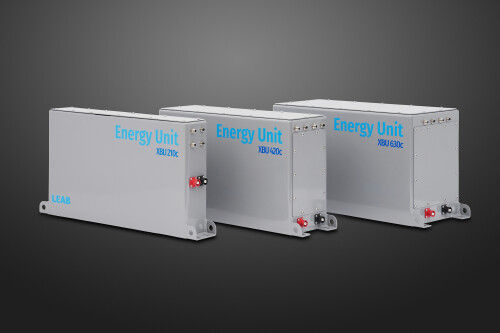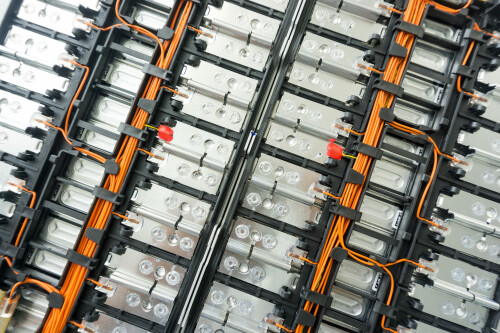
Li-ion batteries of the NCA type are installed in our high-performance energy units.
Batteries are important energy storages in mobile power supply and are used in different variants. Lead batteries are currently the most commonly used energy sources in the automotive sector. However, the trend - significantly influenced by the rapid development in electromobility - is towards modern lithium batteries such as our XBU or the Lithium Power Pack. Here are the most important facts.
There are several types of lithium batteries, which differ in their chemical composition and area of application. These are the most common ones:
Lithium-ion batteries are the most common type of lithium battery and are used in a wide range of electronic devices, such as mobile phones, laptops, tablets and cameras. They offer high energy density and low self-discharge. Li-ion batteries are rechargeable and can go through hundreds of charging and discharging cycles. The best-known type is NCA (lithium nickel cobalt aluminium oxide), which is nowadays the standard in automotive drives and is also installed in our high-performance energy units.
Lithium polymer batteries use a gel or polymer electrolyte layer instead of the liquid electrolyte in Li-ion batteries. This allows the battery to be shaped more flexibly, making it suitable for applications with special form factors, such as thin smartphones or curved wearables. Li-Po batteries also offer high energy density and low self-discharge.
LiFePO4 batteries are known for their improved safety and stability compared to other lithium batteries. They are often used in applications that require high performance and a degree of robustness, such as power tools, electric vehicles and energy storage for photovoltaic systems. LiFePO4 batteries have a longer service life and can undergo a greater number of charging and discharging cycles. The popular all-in-one LPS II relies on this cell chemistry.
Lithium titanate batteries are another type of lithium battery known for their fast recharging time and long life. They have a lower energy density than Li-ion batteries, but are very powerful and can be used in applications that require fast charging and high performance, such as electric vehicles and energy storage systems.
Lithium-air batteries are theoretically very powerful and have an extremely high energy density. They use oxygen from the air as a reagent, which leads to large capacities. However, Li₂O batteries are still in the development and there are still some technical challenges to overcome before they can be used commercially.

Li-ion batteries of the NCA type are installed in our high-performance energy units.
Lithium batteries have experienced a huge boom in recent years and have become one of the most popular energy sources for all kinds of devices and vehicles. They offer numerous advantages, but there are also some disadvantages that one should be aware of.
High energy density
Lithium batteries have a high energy density, which means they can store a lot of energy in a relatively small and lightweight format. This makes them ideal for portable devices such as mobile phones, laptops and tablets, and is what makes today's ranges in electric vehicles possible in the first place.
Low self-discharge
Compared to other battery types, lithium batteries have a low self-discharge rate. This means that they can hold their SOC for a longer period of time, even when not in use. This is especially beneficial for devices that are not used regularly.
Fast charging
Lithium batteries enable faster recharging. Modern lithium batteries can be recharged in an extremely short time, which reduces waiting time and opens up new areas of application.
Long service life
Under optimal conditions, lithium batteries can have a very long service life. They can go through up to several thousand charge and discharge cycles before their capacity noticeably decreases.
High acquisition costs
Lithium batteries are generally more expensive to purchase than other types of batteries. This is partly due to the high material costs and the special manufacturing processes as well as the electronics included for monitoring. However, when considered over their entire useful life, the costs can be put into perspective.
Limited availabiliy
Although lithium is basically widely available as a raw material, there is still a limited availability of high-quality lithium for battery production. Increased demand for lithium batteries may lead to shortages and further drive up prices.
Risks to security
Lithium batteries can pose safety risks if used improperly or damaged. Overheating, short circuits or mechanical damage can lead to fires or explosions. Modern lithium batteries are therefore equipped with various safety mechanisms to keep this risk under control.
Environmental impact
The disposal of lithium batteries is a challenge because they contain toxic substances. If they are incorrectly disposed of, these substances can pollute the environment. Therefore, recycling of the valuable raw materials is essential for cost and environmental reasons. The development of effective recycling processes for lithium batteries is of great importance and will become even more important in the future.
In summary, lithium batteries offer a powerful and efficient energy source for a wide range of applications. Especially in the automotive sector, they are increasingly important for all applications that place high demands on the amount of energy available while requiring little space and weight.

A look inside a lithium battery
Lithium batteries are widely used in many electronic devices and electric vehicles due to their high energy density and durability. Each type of lithium battery has its own advantages and disadvantages and is used in different applications depending on the specific requirements for energy density, performance, durability and safety.
Further development and research in this area aims to further improve the performance and reliability of lithium batteries, but also to reduce prices through lower production and raw material costs.
In view of the rapidly increasing quantities of lithium batteries, the recycling and reuse of spent lithium batteries is also becoming increasingly important. Only in this way will it be possible to cover the demand for raw materials for battery production in the long term and at the same time conserve resources as much as possible.
Do you have any questions about our lithium batteries such as the XBU, the Lithium Power Pack or other solutions in the field of mobile power supply? Our sales team will be happy to answer them.
If you want to learn more about lead-acid batteries, you can find all the information here: